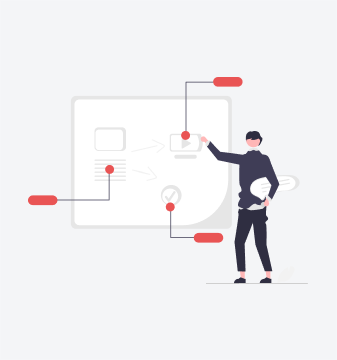Prototyping is a valuable concept that transforms ideas into tangible products. Developing a prototype opens up multiple avenues for product design and development. For example, creating the proper prototype permits testing of product functionality and usability, verification of manufacturing feasibility, and fault finding. This article will explore the applications of prototypes.
What is an Application Prototype?
An application prototype is an early software application model developed to demonstrate its functionality, design features, and overall look and feel. Let us understand the purposes application prototypes serve in the software development process.
Proof of Concept
A prototype demonstrates the feasibility of the concerned software application. It allows the testing of critical functionalities.
Visualisation
A prototype gives stakeholders a tangible sense of what the final software application could look like. It is an essential part of early feedback on the UI/UX of the software application.
Simulation
The simulation feature offered by the prototype provides an idea of the workflow of the concerned application.
Improvements and Modifications
Building a prototype is beneficial for identifying inclusions and exclusions in the final version of the software application.
Now, let us further understand the Java prototype in more detail.
Java Prototype

A Java prototype is a rudimentary model of a Java-based application developed to verify technical feasibility before the commencement of the actual software development efforts. Developing a Java prototype aims to assess the key functionalities in an incomplete and lightweight version of the desired application.
These prototypes are coded to include only the essential functionalities that demonstrate what the natural components in the final application could look like. A Java prototype’s visual fidelity could be much higher. The primary purpose is to provide a skeletal framework for incrementally building the Java application.
Application Prototype Development Process
Let us understand the application prototype development process in detail.
Step 1: Identification of Goals
Based on the inputs from critical stakeholders, questions to be answered with the development process are identified.
Step 2: Sketching Concepts
The next step is to sketch out the ideas and develop initial screen layouts. At this stage, the basic structure of the prototype is developed.
Stage 3: Selecting the Type of Prototype
In this stage, concerned stakeholders identify the type of prototype that would meet their requirements. Depending on the requirements, low fidelity or high fidelity, static or dynamic prototypes can be developed.
Stage 4: Development of Prototype
Based on the decisions taken in the steps above, a prototype is developed using tools such as wireframing applications and mockup tools.
Stage 5: Feedback and Enhancement
The prototype developed will be shared with the concerned stakeholders for their review. Based on these reviews, you are required to make refinements and enhancements. Notably, creating a prototype can take time and effort. The time to develop an application prototype depends on its size, complexity, and intended fidelity.
Based on these factors, the time taken to complete a prototype could vary between some days to several weeks. While low-fidelity prototypes can be completed in a few days, high-fidelity prototypes could take multiple weeks.
Applications of Prototypes
The most critical applications of prototypes are:
Design Vision
The most important application of a prototype is demonstrating the design vision to the stakeholders.
Testing Technical Implementation
Prototypes allow validation of technical architectures, approaches, and algorithms planned for the final version.
Exploring Alternatives
In the prototyping stage, you could develop multiple UX flows and UI options for testing. Exploring several options could lead to better decisions.
Risk Management
A prototype is beneficial in the identification of any potential technical issues. Identifying issues in the initial stages prevents the possibility of any significant risks that could lead to cost and time overruns.
In summary, there are myriad applications of prototypes in software. Despite covering multiple applications, we’ve just scratched the surface.
Final Words
Application prototypes enable the exploration of critical issues related to the final application in a low-fidelity environment. What better approach to failing fast and succeeding sooner than prototyping? In this article, we’ve explored the steps of the prototyping process. We’ve seen that there are myriad applications of application prototyping.




